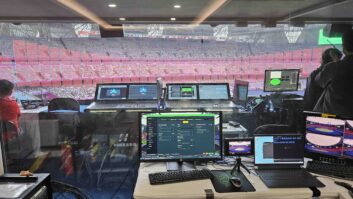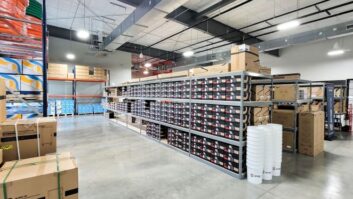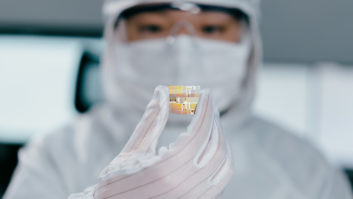With the modern office embracing so many different technologies, how should the designer look to integrate the AV, lighting, HVAC and other control elements? Jonathan Mangnall of AMX Europe gives some pointers.
There are an increasing number of technologies and operating platforms in today’s offices. Things are changing rapidly and for those investing in a building, it is often difficult to plan for the future. But, with a little forward thinking, it is possible to solve the complexity of managing this technology in a reliable, scalable and future-ready way.
By taking technology into consideration early on in the design process you can ensure that a building, and the systems within it, work in an integrated manner, to create a safe, comfortable and vibrant environment that operates to maximum efficiency and productivity. Exercising foresight will allow you to offer your clients the kind of joined-up solution that will maximise their technological investment and ensure that it continues to pay dividends, over the lifetime of their building.
Thanks to digital interconnectivity, it’s never been easier to make provision for new technology. Just providing power and data via an Ethernet socket will allow most people to connect almost anything they want, both now and in future. In some cases these systems will use a network connection (IPTVs, PCs, Wireless Access Points) and in certain circumstances can even be powered over the network (PoE). In other cases Cat 5 or Cat 6 cable can be used to send audio/video signals to a projector, for example, or a video-wall. Nowadays, control and signal management are increasingly being combined within integrated solutions that see single cables carrying power and AV signals, together with control.
Specifying a central control solution that brings together not only the AV systems, but integrates others such as HVAC and BMS functions, is the secret to designing a truly technologically efficient building. Having a single point of control enhances full-facility management by maximising the effective use of space, equipment and energy. These advanced solutions can automate and control all the electronics and content needed for world-class corporate communication and operation. From audio-visual equipment, media-driven presentation facilities and video-conferencing; to HVAC, window treatments and lighting – today’s control technology can ensure that a building’s integrated systems are centrally managed and easily controlled, all at the touch of a button. And, by choosing a fully integrated solution, end-users save on infrastructure costs and lower overall energy consumption, they also benefit from a smaller technological footprint and fewer possible points of failure within their systems.
Don’t forget to also consider how your client’s equipment might be used, and coordinate it accordingly. If you think they might have a projector in a certain position, allow power and a control cable (Cat 5 is fine again) to where the screen might go, and think about taking audio from where the presenter’s computer might go. Provision for cabling for loudspeakers also needs to be made, and don’t design bright lights between the projector and the screen, unless you can control these easily.
We all need reliable, clear, up-to-date communications to make the most of the working day. The latest generation of network, signage and communications systems ensure that everyone can benefit from a technological investment. Nowadays we can take advantage of integrated Voice over IP (VOIP) functionality which allows users to make free telephone and intercom calls from touchpanels, as well as other connected devices; whilst a robust wireless network will help to make life as convenient as possible, ensuring that systems work equally well, anywhere in the building. This means that users can use cordless or mobile telephones, or take advantage of active RFID systems. Their presence can be automatically detected by sensors, unlocking doors, or alerting staff as required.
When thinking about a communications infrastructure, consider multipurpose use for displays. Don’t just have a reception TV displaying CNN or daytime TV. Connect a PC so your clients can show presentations or other information, or better still, connect it to a simple digital signage system so they can display corporate information, news feeds, advertising etc. They can distribute and automate presentations, animated signage and CCTV images, as well as in-house content. The system can also be used for way-finding in larger buildings and you can even have it react to triggered events, such as relaying evacuation and assistance information in the event of an emergency. Your clients can use a control system to monitor and operate this easily and locally, or from head office if they wish. These systems can be used to keep control of the quality, consistency and timing of messages so that staff and customers get maximum benefit.
Finally, if you can, speak to your clients about simple energy management. Power monitoring and the ability to have highly granular control over which devices power-up and when, is now a fundamental consideration when designing solutions that maximise end-user benefit. Whilst it has always been possible to provide solutions that switch off the majority of the equipment in a rack when the system is not in use, there are now products which take this one step further and offer control at rack-level; allowing the control system to monitor all aspects of power usage within a rack and reporting back to a central management system. The data gathered can then be used locally to minimise energy consumption, dependent upon the functionality required in the room at the time.
And, did you know that modern lighting control systems allow the artificial lighting to react to the levels of daylight (as well as occupancy). You can provide local scene-setting switches to help people save energy or get the quality of light they need. It’s also possible to use automated blinds to reduce glare and minimise solar gain, avoiding the need for cooling. Taken together, these steps can make a massive difference to a company’s energy consumption. Now that’s something to show on the digital signage system!
Jonathan Mangnall is sales director at AMX Europe







